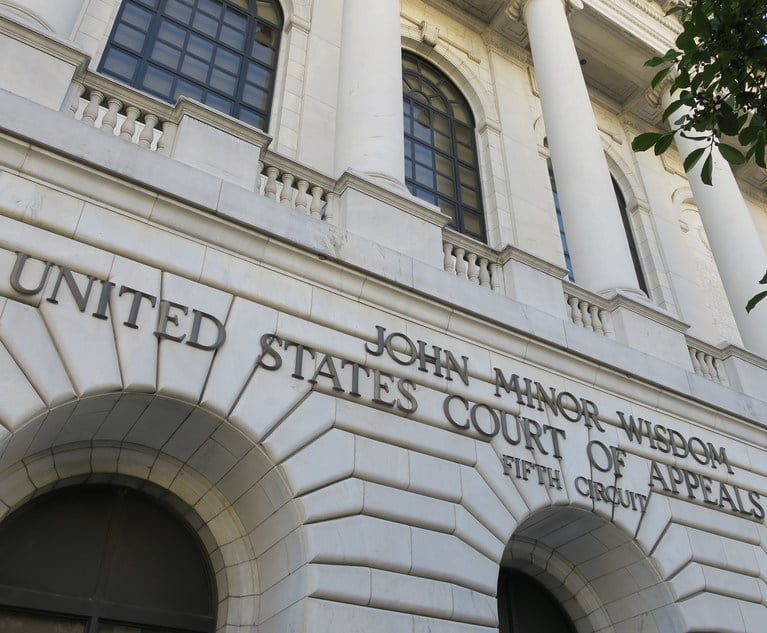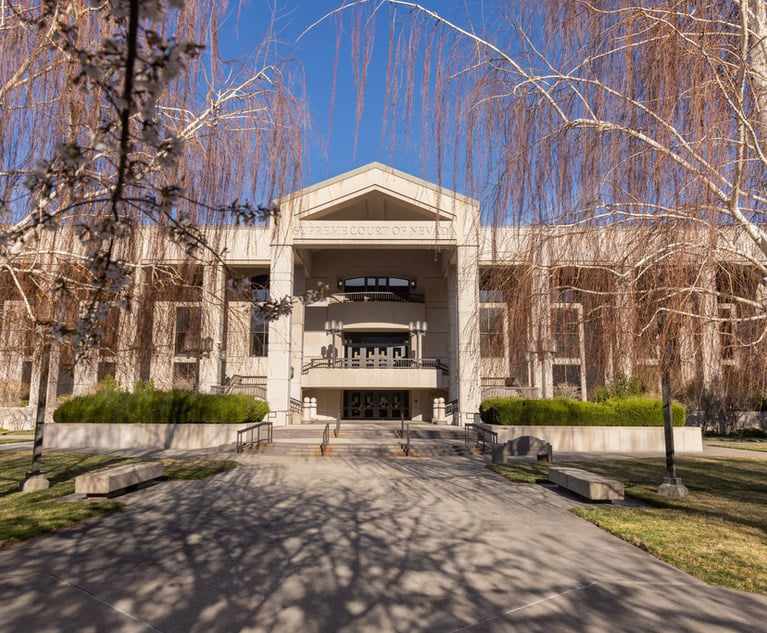Chai Feldblum Reflects on Her EEOC Tenure—and What's Next
Feldblum, who left the EEOC in January, will now start a new venture with her longtime chief of staff, Sharon Masling, to help companies implement anti-harassment strategies.
February 04, 2019 at 05:19 PM
7 minute read
 Chai Feldblum/courtesy photo
Chai Feldblum/courtesy photoChai Feldblum, then a member of the U.S. Equal Employment Opportunity Commission, watched for over nine years as the courts and regulatory policies embraced progressive ideals of greater workplace equality for disabled, LGBT and minority workers.
As the U.S. Supreme Court appears poised to review a slate of civil rights cases, Feldblum now will watch from a different vantage.
Feldblum, an Obama-era appointee who was the first openly gay commissioner on the EEOC, was denied a chance to continue serving. President Donald Trump renominated her, but U.S. Senate Republicans, fearing she would undermine religious rights in favor of LGBT protections, blocked her advancement. Feldblum has flatly denied this characterization.
Feldblum, who left the EEOC in January, will now start a new venture with her longtime chief of staff, Sharon Masling, to help companies implement anti-harassment strategies. The new venture is in its early stages, but it builds off a 2016 EEOC report aimed at preventing harassment in the workplace.
Feldblum spoke with the NLJ recently about her time on the commission, changes in the law and what's next. The following highlights from the conversation were edited for length and clarity.
NLJ: What will your next venture look like?
Feldblum: For years, employers have had their policies and their procedures, and they've done training. We know from the research [that] that hasn't been sufficient. In June 2016, together with my colleague Victoria Lipnic [current interim chairwoman of the EEOC], we put out a report that is truly a road map for how to do it differently. But a road map is only that. Now, we will look at how do we help them implement that road map in a way that works for them. The report is a broad-brush picture of an overall general approach. It is not easy to change your workplace culture so that harassment is simply not tolerated, but it is possible to do that. Research showed that with the right leadership, the right rules of accountability and then with the right policies, procedures and training, those things together can help shape a workplace culture so that harassment is much less likely to occur.
➤➤ Get employment law news and commentary straight to your in-box with Labor of Law, a new Law.com briefing. Learn more and sign up here.
How did the #MeToo movement change the conversation and affect the way the EEOC handled the harassment guidelines?
We went into this in 2015 because we were frustrated that things had not changed enough in stopping harassment. We were well aware of that. We were very committed to enforcement, but we felt enforcement clearly wasn't sufficient. So what can we come up with that would be about prevention? Now, if you had asked me in June 2016 what was the biggest roadblock to getting the recommendations of the report adopted, I would have said shifting people's attention by getting people to care about reading these recommendations. After the #MeToo movement began, suddenly, employers started to focus. The media started to focus. The average person on the street started to focus. And what that now means is there is an opportunity to give people.
What do you consider to be some some of your achievements at the EEOC?
One of the pieces I'm very proud of is what the EEOC has done on correcting the law on Title VII sex discrimination and coverage of sexual orientation and gender identity. The courts had actually sort of been moving in that direction but it wasn't really getting the visibility and it wasn't as explicit as we had done it at the EEOC. We were the first agency that was interpreting the law. We interpreted it that way and the courts went along. The EEOC corrected, in my mind, the mistake with our analysis. And again that's what has enabled the courts to look at it again.
The second issue is the accommodations that pregnant workers get under the Pregnancy Discrimination Act. And that was one where four circuit courts of appeals had ruled in a way that I simply thought was wrong—that even if you gave light duty to someone injured on the job you had no obligation to give light duty work to someone who was pregnant and wanted to stay on the job. And ultimately, we issued guidance that said, “You do have to give light duty to a pregnant worker.” We had two different legal theories as to why and in the Young v. UPS case the Supreme Court adopted one of those theories.
The third substantive area for me is unemployment of people with disabilities. Over a five-year process, the agency issued expanded regulations under Section 5 of one of the Rehabilitation Act of 1973, which requires federal agencies to take affirmative action in the hiring of people with disabilities and really gain for the first time meaning and detail how that affirmative action application works.
The Supreme Court has several LGBT workplace cases, but it doesn't appear the court will take action on the petitions for this term. What are your thoughts on what's happening?
The [U.S. Court of Appeals for the] Eighth Circuit has that issue pending before it right now. Why not just wait until more of the circuit courts of appeal deal with this question. I don't see any particular need for the Supreme Court to rush in right now. This is precisely where you want to have it percolate in the appellate courts. Maybe it needs more time to be riper. The question of gender identity, obviously there's not much dispute in the lower courts. There's not a conflict in the circuit in regard to gender identity.
What do you make of the clash between the EEOC and the Justice Department over the Title VII question? The Justice Department, against the EEOC, argues that LGBT workers should not be covered under the federal civil rights law.
It shows the difference between having an independent agency, a bipartisan commission, that is the EEOC. Unlike other things, where a snap of the fingers you can change your position, that doesn't happen with multimember commissions. And it's no surprise that the EEOC has not changed its position and it won't change its position unless there's a majority that wants to vote to change it.
What do you make of Sen. Mike Lee's opposition to your nomination? Do you have a takeaway?
Perhaps counterintuitively, I actually take some solace. I'm actually quite gratified by the extent of support that I had from businesses.The bottom line is that the top Republican leaders were very comfortable to have me be on the commission for another term together with the two Republican nominees that President Trump had put forward. So to me, and in a world where it seems there's never bipartisanship, actually the story of my nomination is that there was strong bipartisanship among the Republicans in the Senate to allow that package to go forward.
However, it's simply a story of the reality of the Senate. Just one senator who objects for a reason—even if not grounded in reality—can bring down even what his party wants. I've been in politics for 30 years and I understand how it works. So, you know, I'm not upset by that.
Read more:
This content has been archived. It is available through our partners, LexisNexis® and Bloomberg Law.
To view this content, please continue to their sites.
Not a Lexis Subscriber?
Subscribe Now
Not a Bloomberg Law Subscriber?
Subscribe Now
NOT FOR REPRINT
© 2025 ALM Global, LLC, All Rights Reserved. Request academic re-use from www.copyright.com. All other uses, submit a request to [email protected]. For more information visit Asset & Logo Licensing.
You Might Like
View All
Legal Issues to Watch in the US Appeals Courts in 2025

Second Circuit Upholds $5M Judgment Against Trump in E. Jean Carroll Case
4 minute read
Divided 5th Circuit Shoots Down Nasdaq Diversity Rules

Nevada Supreme Court to Decide Fate of Groundbreaking Contingency Cap Ballot Measure
5 minute readTrending Stories
- 1The Fearless Forecaster’s Employment Law Predictions for 2025
- 2Judicial Conference Declines Democratic Request to Refer Justice Thomas to DOJ
- 3People in the News—Jan. 2, 2025—Eastburn and Gray, Klehr Harrison
- 4Deal Watch: Latham, Paul Weiss, Debevoise Land on Year-End Big Deals. Plus, Mixed Messages for 2025 M&A
- 5Bathroom Recording Leads to Lawyer's Disbarment: Disciplinary Roundup
Who Got The Work
Michael G. Bongiorno, Andrew Scott Dulberg and Elizabeth E. Driscoll from Wilmer Cutler Pickering Hale and Dorr have stepped in to represent Symbotic Inc., an A.I.-enabled technology platform that focuses on increasing supply chain efficiency, and other defendants in a pending shareholder derivative lawsuit. The case, filed Oct. 2 in Massachusetts District Court by the Brown Law Firm on behalf of Stephen Austen, accuses certain officers and directors of misleading investors in regard to Symbotic's potential for margin growth by failing to disclose that the company was not equipped to timely deploy its systems or manage expenses through project delays. The case, assigned to U.S. District Judge Nathaniel M. Gorton, is 1:24-cv-12522, Austen v. Cohen et al.
Who Got The Work
Edmund Polubinski and Marie Killmond of Davis Polk & Wardwell have entered appearances for data platform software development company MongoDB and other defendants in a pending shareholder derivative lawsuit. The action, filed Oct. 7 in New York Southern District Court by the Brown Law Firm, accuses the company's directors and/or officers of falsely expressing confidence in the company’s restructuring of its sales incentive plan and downplaying the severity of decreases in its upfront commitments. The case is 1:24-cv-07594, Roy v. Ittycheria et al.
Who Got The Work
Amy O. Bruchs and Kurt F. Ellison of Michael Best & Friedrich have entered appearances for Epic Systems Corp. in a pending employment discrimination lawsuit. The suit was filed Sept. 7 in Wisconsin Western District Court by Levine Eisberner LLC and Siri & Glimstad on behalf of a project manager who claims that he was wrongfully terminated after applying for a religious exemption to the defendant's COVID-19 vaccine mandate. The case, assigned to U.S. Magistrate Judge Anita Marie Boor, is 3:24-cv-00630, Secker, Nathan v. Epic Systems Corporation.
Who Got The Work
David X. Sullivan, Thomas J. Finn and Gregory A. Hall from McCarter & English have entered appearances for Sunrun Installation Services in a pending civil rights lawsuit. The complaint was filed Sept. 4 in Connecticut District Court by attorney Robert M. Berke on behalf of former employee George Edward Steins, who was arrested and charged with employing an unregistered home improvement salesperson. The complaint alleges that had Sunrun informed the Connecticut Department of Consumer Protection that the plaintiff's employment had ended in 2017 and that he no longer held Sunrun's home improvement contractor license, he would not have been hit with charges, which were dismissed in May 2024. The case, assigned to U.S. District Judge Jeffrey A. Meyer, is 3:24-cv-01423, Steins v. Sunrun, Inc. et al.
Who Got The Work
Greenberg Traurig shareholder Joshua L. Raskin has entered an appearance for boohoo.com UK Ltd. in a pending patent infringement lawsuit. The suit, filed Sept. 3 in Texas Eastern District Court by Rozier Hardt McDonough on behalf of Alto Dynamics, asserts five patents related to an online shopping platform. The case, assigned to U.S. District Judge Rodney Gilstrap, is 2:24-cv-00719, Alto Dynamics, LLC v. boohoo.com UK Limited.
Featured Firms
Law Offices of Gary Martin Hays & Associates, P.C.
(470) 294-1674
Law Offices of Mark E. Salomone
(857) 444-6468
Smith & Hassler
(713) 739-1250










